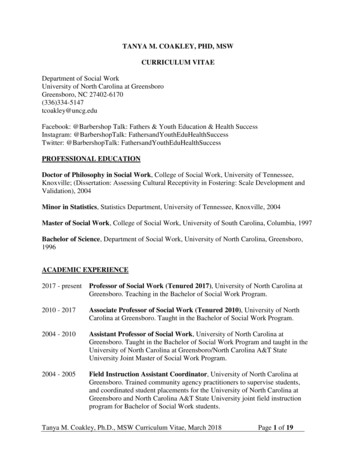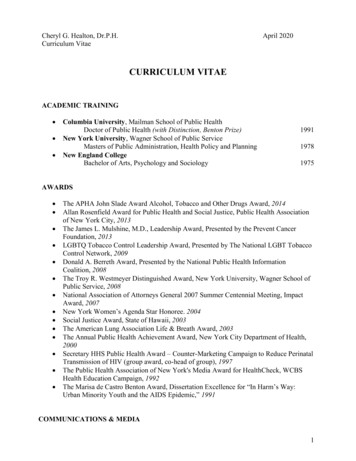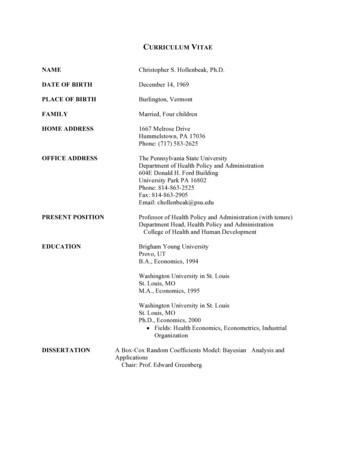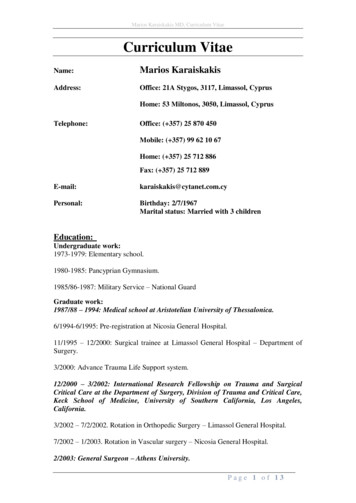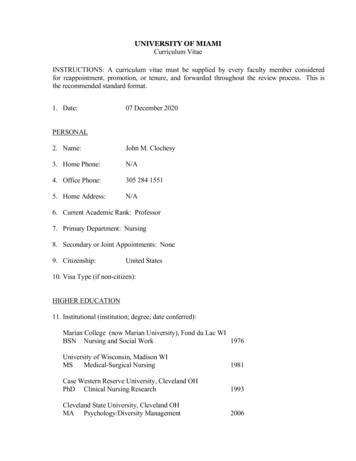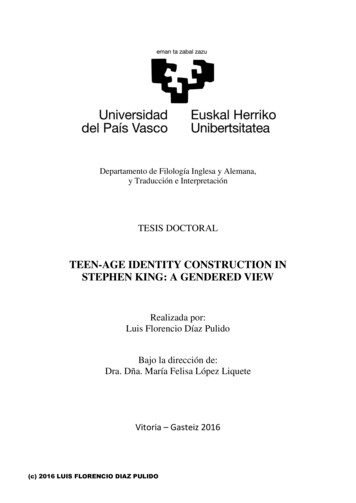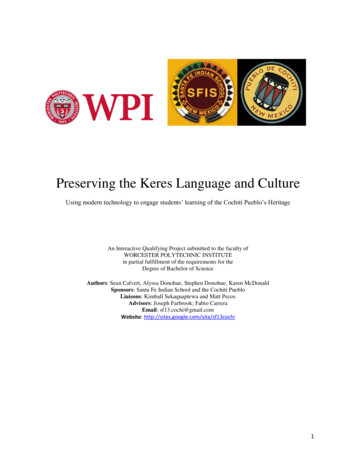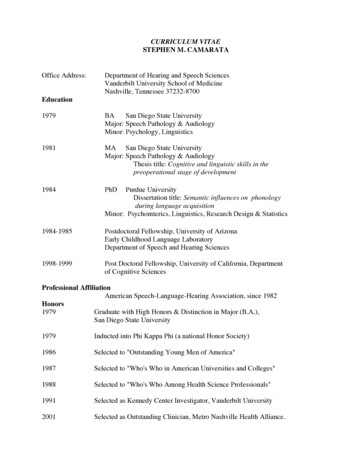
Transcription
CURRICULUM VITAESTEPHEN M. CAMARATAOffice Address:Department of Hearing and Speech SciencesVanderbilt University School of MedicineNashville, Tennessee 37232-8700Education1979BASan Diego State UniversityMajor: Speech Pathology & AudiologyMinor: Psychology, Linguistics1981MA San Diego State UniversityMajor: Speech Pathology & AudiologyThesis title: Cognitive and linguistic skills in thepreoperational stage of development1984PhD1984-1985Postdoctoral Fellowship, University of ArizonaEarly Childhood Language LaboratoryDepartment of Speech and Hearing Sciences1998-1999Post Doctoral Fellowship, University of California, Departmentof Cognitive SciencesPurdue UniversityDissertation title: Semantic influences on phonologyduring language acquisitionMinor: Psychomterics, Linguistics, Research Design & StatisticsProfessional AffiliationAmerican Speech-Language-Hearing Association, since 1982Honors1979Graduate with High Honors & Distinction in Major (B.A.),San Diego State University1979Inducted into Phi Kappa Phi (a national Honor Society)1986Selected to "Outstanding Young Men of America"1987Selected to "Who's Who in American Universities and Colleges"1988Selected to "Who's Who Among Health Science Professionals"1991Selected as Kennedy Center Investigator, Vanderbilt University2001Selected as Outstanding Clinician, Metro Nashville Health Alliance.
2002Distinguished Faculty Award, Vanderbilt University2012Elected Fellow, American Speech-Language-Hearing Association2014Appointed to Committee on Research, American SpeechLanguage-Hearing AssociationAcademic Appointments1985-1988Assistant Professor, Special Education and CommunicationDisorders, Pennsylvania State University1988-1990Assistant Professor of Speech and Hearing SciencesAutism Research CenterUniversity of California, Santa Barbara1990-1994Assistant Professor of Hearing and Speech Sciences,Vanderbilt University School of Medicine1990-presentDirector, Scottish Rite Child Language Disorders Center,Bill Wilkerson Center, Vanderbilt University1991-presentInvestigator, John F. Kennedy Center for Research in HumanDevelopment, Vanderbilt University1994-2000Associate Professor of Hearing and Speech Sciences,Vanderbilt University School of Medicine1999-presentAssociate Professor of Special Education, GeorgePeabody College of Education, Vanderbilt University2000-2002Acting Director, John F. Kennedy Center for Research inHuman Development, Vanderbilt University1999-2008Deputy Director, John F. Kennedy Center for Research inHuman Development, Vanderbilt University2000-presentProfessor, Department of Hearing & Speech SciencesVanderbilt University School of Medicine.Clinical Practice1981-1982Clinical Fellow, Purdue University Speech and Hearing Clinic1985-1988Clinical Supervisor, The Pennsylvania State University, UniversityPark, PA. Caseload includes language disorders and children withmental retardation.1988-1990Consultant, Autism Research Center, University of California, Santa2
Barbara. Caseload includes children with autism and with mentalretardation1990-presentDirector and Lead Clinician, Scottish Rite Child Language DisordersCenter. Caseload includes children speech and language disorders,children with autism and with mental retardation.1999-2004Co-Founder and Lead Speech Pathologist: Down Syndrome Clinic,Vanderbilt University Children’s Hospital.2001-2008Director and Lead Clinician, Vanderbilt-Kennedy Center Late TalkerClinic.CertificationsSince 1982Certificate of Clinical Competence, American Speech-LanguageHearing Association CCC-SLPSince 2000Autism Diagnostic Observation Schedule (ADOS)Since 2013Autism Diagnostic Observation Schedule, Second edition (ADOS-2)Since 2013Autism Diagnostic Observation Schedule, Second edition (ADOS2), Research Reliable.Extramural Support for Research Program1984-1985Noun and verb production in language impaired children, Office ofEducation Award for postdoctoral study. Completed within the EarlyChildhood Language laboratory, University of Arizona. Total: 29,9601989-1993NIH NIDCD-R01NS26437, Experimental studies of language learningprocesses. (Keith Nelson, PI); Vanderbilt subcontract (Camarata, PI).Project Period Direct Costs: 418,000. Total: 989,6231993-1995US Department of Education-H023A30052, Evaluation of naturalisticconversation training for improving speech intelligibility in studentswith severe disabilities, Principal Investigator. Total: 74,9981993-1996US Department of Education-H029C30070, Improving speech andlanguage learning disabilities using naturalistic teaching procedures,Principal Investigator. Total: 509,3041993-1997NIH NIDCD-R01NS01420, Phonological treatment effects in languagedisordered children, Principal Investigator. Total: 698,6181997-2002NIH NIDCD-R01DC00508, Experimental Studies of LanguageLearning Processes (Keith Nelson, PI); Vanderbilt subcontract(Camarata, PI). Total: 399,8403
1998-2003NIH NIDCD-P50DC03282, Language Intervention, PrincipalInvestigator, (Ann Kaiser, Keith Nelson, Steve Warren, Paul Yoder, CoPrinicpal Investigators). Total: 4,718,0001999-2002NIH NICHD-P3OHD15052, John F. Kennedy Center for Mental Retardation,Principal Investigator (2000-2002), Total: 6,319,4212000-2005NIH NIDCD-R01DC04544, Grammatical Morphology in SpecificLanguage Impairment (Laurence Leonard, PI); Vanderbilt subcontract(Camarata, PI). Total: 923, 1272002-2004NIH NICHD-R03HD42509, Speech-intelligibility in Down Syndrome.Principal Investigator, Total: 152,0002003-2008NIH DCD-R01 Teaching articulation and grammar to children withSLI. (Paul Yoder, PI, Stephen Camarata, CoI).2007-2010NIH: NIDCD R01 Treatment of Speech Disorders in Down Syndrome.Stephen Camarata (PI). Total Costs: 958,951.2008-2011IES R324A080143: Related Services Intervention for Expressive andReceptive Language Skills in ASD and in CI. Stephen Camarata, PI.2009-2011NIH NIDCD R34: Evaluation of Sensory Integration Treatment inASD. Stephen Camarata, PI. Total: 685,5002009-2013IES R32: Early Childhood Intervention for Language Disorders. PI:Ann Kaiser, Co-I S, Camarata2010-2014IES R32: Related Services Intervention for Down Syndrome. PI: PaulYoder, Co-I S, Camarata2011-2015IES R32: Listening effort in children with hearing impairment (PI: FredBess; CoI Stephen Camarata)PublicationsBookCamarata, S. (2014). Late-Talking Children: A Symptom or a Stage? Cambridge, MA:MIT Press.Peer Reviewed Articles and Chapters1. Camarata, S., Newhoff, M., & Rugg, B. (1981). Perspective taking in normal andlanguage impaired children. The Symposium for Research in Child LanguageDisorders, 2, 32-45.4
2. Leonard, L., Camarata, S., Schwartz, R., Rowan, L., & Chapman, K. (1982). Thecommunicative functions of lexical usage by language impaired children. AppliedPsycholinguistics, 3, 109-125.3. Camarata, S. & Gandour, J. (1984). On describing idiosyncratic phonologicsystems. Journal of Speech and Hearing Disorders, 49, 262-266.4. Camarata, S., Newhoff, M., & Rugg, B. (1985). Classification skills and languagedevelopment in language impaired children. Australian Journal of HumanCommunication, 13, 107-116.5. Camarata, S. & Gandour, J. (1985). Rule invention in the acquisition ofmorphology. Journal of Speech and Hearing Disorders, 50, 40-45.6. Camarata, S. & Schwartz, R. (1985). Production of object words and action words:Evidence for a relationship between phonology and semantics. Journal ofSpeech and Hearing Research, 28, 323-330.7. Camarata, S. & Leonard, L. (1985). Children's production of nouns and verbs:Evidence for a semantic phonological interaction. Papers and Reports in ChildLanguage, 24, 38-45.8. Camarata, S. & Gandour, J. (1985). Evidence for the feature [diffuse]. Journal ofPhonetics, 13, 473-475.9. Leonard, L., Camarata, S., Schwartz, R., Chapman, K., & Messick, C. (1985).Homonymy and the voiced-voiceless distinction in the speech of children withspecific language impairment. Journal of Speech and Hearing Research, 28,215-224.10. Schwartz, R., & Camarata, S. (1985). Examining relationships between input andlanguage development: Some statistical issues. Journal of Child Language, 12,199-207.11. Camarata, S. & Leonard, L. (1986). Young children pronounce object words moreaccurately than action words. Journal of Child Language, 13, 51-65.12. Camarata, S. & Erwin, L. (1987). The long and the short of it: Plural production in alanguage disordered child. Symposium for Research in Child Language, 7,95-101.13. Camarata, S., Hughes, C., & Ruhl, K. (1988). Children with mild to moderatebehavior disorders: A population at risk for language impairment. Language,Speech, and Hearing Services in Schools, 19, 191-200.14. Camarata, S. (1988). Iconicity in semantics: Suprasegmental marking in theacquisition of the English plural. Papers and Reports in Child Language, 27,38-45.15. Camarata, S. & Erwin, L. (1988). Rule invention in the acquisition of morphologyrevisited: A case of transparent semantic mapping. Journal of Speech andHearing Research, 31, 425-431.16. Datillo, J. & Camarata, S. (1988). Combining speech pathology and therapeuticrecreation to encourage self determination for persons with disabilities. Journalof Expanding Horizons in Therapeutic Recreation, 3, 12-17.17. Camarata, S. (1989). Final Consonant repetition: A linguistic perspective. Journalof Speech and Hearing Research, 54, 159-162.18. Camarata, S. & Swisher, L. (1990). A note of intelligence assessment within studiesof specific language impairment. Journal of Speech and Hearing Research, 33,205-207.5
19. Camarata, S. (1990). Semantic iconicity in plural acquisition: Extending theargument to normal children. Clinical Linguistics and Phonetics, 4, 319-325.20. Dattilo, J. & Camarata, S.* (1991). Facilitating conversation through self-initiatedaugmentative communication treatment. Journal of Applied Behavior Analysis.24, 369-378. *Authorship of this paper is equal.21. Camarata, S. (1991). Assessment of oral language. In J. Salvia & J. Ysseldyke(Eds.), Assessment in special and remedial education. Boston: HoughtonMifflin.22. Camarata, S. & Nelson, K. (1992). Treatment efficiency as a function of targetselection in the remediation of child language. Clinical Linguistics andPhonetics, 6, 167-178.23. Ruhl, K., Hughes, C., & Camarata, S. (1992). Analysis of the expressive andreceptive language characteristics of emotionally handicapped students servedin public school settings. Journal of Childhood Communication Disorders, 14,165-176.24. Camarata, S. (1993). The application of naturalistic conversation training to speechproduction in children with speech disabilities. Journal of Applied BehaviorAnalysis, 26, 173-182.25. Nelson, K.E., Loncke, F., & Camarata, S. (1993). Implications of research on deafand hearing childrens language learning. In M. Marschark & D. Clark (Eds.),Psychological perspectives on deafness (pp. 123-151). Hillsdale, NJ: LawrenceErlbaum.26. Haley, K., Camarata, S., & Nelson, K. (1994). Social valence in children withspecific language impairment during imitation-based and conversation-basedlanguage intervention. Journal of Speech and Hearing Research, 37, 378-388.27. Camarata, S., Nelson, K. E., & Camarata, M. (1994). Comparison ofconversational-recasting and imitative procedures for training grammaticalstructures in children with specific language impairment. Journal of Speech andHearing Research, 37, 1414-1423.28. Camarata, S. (1995). A rationale for naturalistic speech intelligibility intervention.In M. Fey, J. Windsor, and S. Warren (Eds.), Language intervention: preschoolthrough the early school years (pp. 63-84). Baltimore: Brookes.29. Nelson, K. E., Welsh, J., Camarata, S., Butkowsky, L., & Camarata, M. (1995).Available input and available language learning mechanisms for specificallylanguage-delayed and language-normal children. First Language, 15, 1-17.30. Koegel, R. L., Camarata, S. M., and Koegel, L. K. (1995). Aggression and noncompliance: Behavior modification through naturalistic language remediation.In J. L. Matson (Ed.), Autism in children and adults: Etiology, assessment, andintervention (pp. 165-180). Pacific Grove, CA: Brooks Cole Publishing Co.31. Camarata, S. (1996). On the importance of integrating naturalistic language, socialintervention, and speech-intelligibility training. In L. Koegel, R. Koegel, & G.Dunlap (Eds.), Positive behavior support (pp. 333-351). Baltimore: Brookes.32. Champion, T., Seymour, H., & Camarata, S. (1996). Narrative discourse of AfricanAmerican Children. Journal of Narrative and Life History, 5, 333-352.33. Nelson, K. E., Camarata, S., Welsh, J., Butkovsky, L., Camarata, M. (1996). Effects ofimitative and conversational recasting treatment on the acquisition of grammar inchildren with specific language impairment and younger language-normal6
children. Journal of Speech and Hearing Research, 39, 850-859.34. Camarata, S., Nelson, K., & Camarata, M. (1996). On the importance of providingdetailed procedural descriptions in treatment research. Journal of Speech andHearing Research, 39, 222-223.35. Nelson, K., & Camarata, S. (1996). Improving English literacy and speech acquisitionlearning conditions for children with severe to profound hearing impairments.Volta Review, 98(2) , 17-41.36. Camarata, S. (1997). Assessment of oral language. In J. Salvia & J. Ysseldyke(Eds.), Assessment in special and remedial education. Boston: HoughtonMifflin. (Revised and expanded version of the chapter originally prepared in1991).37. Koegel, L., Camarata, S., & Valdez-Menchaca, M. (1998). Setting generalization ofquestion-asking by children with autism. American Journal of Mental Retardation,102, 346-357.38. Koegel, R., Camarata, S., Koegel, L., Ben-Tal, A., & Smith, A. (1998). Increasingspeech intelligibility in children with autism. Journal of Autism andDevelopmental Disorders, 28(3), 243-251.39. Camarata, S. (1999). Connecting speech and language: clinical applications. In R.Paul (Ed.), Exploring the speech-language connection (Vol. 8, pp. 299-319).Baltimore: Brookes.40. Smith, A., & Camarata, S. (1999). Using teacher-implemented instruction toincrease language intelligibility of children with autism. Journal of PositiveBehavior Interventions, 1(3), 141-151.41. Camarata, S. & Gibson, T. (1999). Pragmatic Language Deficits in AttentionDeficit Hyperactivity Disorder (ADHD). Journal of Mental Retardation andDevelopmental Disabilities Research Reviews, 5, 207-214.42. Camarata, S.M. (2000). The Pragmatics of Paediatric Language Intervention: Issuesand Analysis. In Nicole Müller (Ed.), Pragmatics in Speech and LanguagePathology: Studies in Clinical Applications (pp. 139-163) Amsterdam: JohnBenjamins Publishing Co.43. Nelson, K., Welsh, J., Camarata, S., Tjus, T., & Heimann, M. (2001). A Rare EventTransactional Model of Tricky Mix Conditions Contributing to LanguageAcquisition and Varied Communicative Delays. Children's Language:Interactional Contributions to Language Development (Vol. 11, pp. 165-195).Mahwah, New Jersey: Lawrence Erlbaum Associates, Publishers.44. Camarata, S. & Yoder, P. (2002). Language transactions during developmentand intervention: Theoretical implications for developmentalneuroscience. International Journal of Developmental Neuroscience. 20,459-467.45. Camarata, S. & Nelson, K. E. (2002). Measurement and the diagnosis ofspeech and language disorders in children. Peabody Journal of Education,77(2), 106-116.46. Gillum. H., Camarata, S., & Nelson, K. E., Camarata, M. (2003). Pre-interventionimitation skills as a predictor of treatment effects in children with specificlanguage impairment. Journal of Positive Behavior Intervention, 5(3), 171-178.7
47. Camarata, S., & Conture, E. (2003). Disorders of speech and languagedevelopment. In M. Wolraich (Ed.), Disorders of development andlearning (3rd ed., pp. 175-194). Hamilton, Ontario: B.C. Decker, Inc48. Camarata, S. (2003). Assessment of language and language disorders. In M.Wolraich (Ed.), Disorders of development and learning (3rd ed., pp. 4960). Hamilton, Ontario: B.C. Decker, Inc.49. Gillum, H., & Camarata, S. (2004). Importance of treatment efficacy researchon language comprehension in MR/DD research. Mental Retardation andDevelopmental Disabilities Research Reviews, 10, 201-207.50. Haines, J., & Camarata, S. (2004). Examination of candidate genes inlanguage disorder: A model of genetic association in treatment studies.Mental Retardation and Developmental Disabilities Research Reviews, 10,208-217.51. Camarata, S., & Wertz, R. T. (2004). Treatment efficacy research: A windowinto genetic and neurodevelopmenteal correlates of developmentaldisabilities. Mental Retardation and Developmental Disabilities ResearchReviews, 10, 159-162.52. Leonard, L., Camarata, S., Brown, B., & Camarata, M. (2004). Tense andagreement in the speech of children with specific language impairment:Patterns of generalization through intervention. Journal of SpeechLanguage-Hearing Research. 47, 1363-1379.53. Yoder, P., Camarata, S., & Gardner, E. (2005). Treatment effects on speechintelligibility and length of utterance in children with specific languageand intelligibility impairments. Journal of Early Intervention. 28, 34-4954. Camarata, S. (2005). Differential Diagnosis of Autism and other Developmental Disabilitiesin International Adoption Cases: The Implications of Language Abilities: Journal ofCognitive Education and Psychology, 5, 2005, 89-102.55. Camarata, S., & Nelson, K. (2006). Conversational Recast Intervention withPreschool and Older Children. In R. McCauley & M. Fey (Eds.),Treatment of language disorders in children. (pp. 237-264). Baltimore:Brookes Publishing.56. Leonard, L., Camarata, S., Pawlowska, M., Brown, B. & Camarata, M.(2006). Tense and Agreement Morphemes in the Speech of Children withSpecific Language Impairment During Intervention: Phase II. Journal ofSpeech-Language-Hearing Research, 49, 749-770.57. Yoder, P., Camarata, S., Camarata, M. & Williams, S. (2006). Associationbetween differentiated processing of syllables and comprehension ofgrammatical morphology in children with Down syndrome. AmericanJournal on Mental Retardation. 111, 138-152.58. Camarata, S. & Woodcock, R. (2006). Sex Differences in Processing Speed:Developmental Effects in Males and Females. Intelligence. 34, 231-25259. Camarata, S., Yoder, P., & Camarata, M. (2006). Simultaneous treatment ofgrammatical and speech-comprehensibility deficits in children with Downsyndrome. Down Syndrome Research and Practice, 11, 9-17.60. Leonard, L., Camarata, S., Brown, B. & Camarata, M. (2008). Theacquisition of tense and agreement in the speech of children with specific8
language impairment: Patterns of generalization through intervention.Journal of Speech-Language-Hearing Research, 51, 120-125.61.Powlowska, M. Leonard, L. Camarata, S., Brown, B. & Camarata, M. (2008).Factors accounting for the ability of children with SLI to learn agreementmorphemes in intervention. Journal of Child Language, 35, 25-53.62. Camarata, S. (2008). Fast ForWord does not significantly improve languageskills in children with language disorders. Evidence-BasedCommunication Assessment and Intervention, 2. 96-98.63. Camarata, S., Nelson, K., Gillum, H. & Camarata, M. (2009). IncidentalReceptive Language Growth Associated with Expressive GrammarIntervention in SLI. First Language, 29, 51-63.64. Koegel, R., Koegel, L., & Camarata, S. (2010). Definitions of empiricallysupported treatment. Journal of Autism and Developmental Disorders, 40,516-517.65. Camarata, S. (2010). Word based phonological intervention: Issues andevidence (pp. 381-406). In L. Williams, S. McCloud & R. McCauley(Eds.) Phonological intervention in children. Baltimore: Brookes.66. Craig-Unkefer, L. & Camarata, S. (2010). Language intervention in AAEspeaking children. Topics in Language Disorders, 30, 205-222.67. Camarata, S., & Camarata, M. (2010). Cognitive and Achievement Correlatesof Language Disorders. Comprehensive Evaluations: Case Reports forPsychologists, Diagnosticians, and Special Educators, 5, 23. In N. Mather & L.Jaffe (Eds.), Assessment in Clinical and School Psychology. Baltimore: Brookes.68. Stevenson, R., Siemann, J., Eberly, H., Schneider, B., Camarata, S., &Wallace, M. (2012). Atypical development of temporal perception in ASD isassociated with deficits in audiovisual speech integration. Journal of Vision,12(9),1034-1034.69.Camarata, S. (2012). Perspective: Think Developmentally. The ASHA Leader.70.Camarata, S. (2013). Pediatric Hearing Impairment, Autism, and AutismSpectrum Disorder: Implications for Clinicians. SIG 9 Perspectives on Hearingand Hearing Disorders in Childhood, 23(1), 4-12.71. Camarata, S. (2013) Which Late Talkers Require Intervention? MatchingChild Characteristics and Risk Factors to Treatment. In L. Rescorla and P. Dale(Eds.). Research on Late Talkers. Baltimore: Brookes.72. Stevenson, R. A., Siemann, J. K., Schneider, B. C., Eberly, H. E.,Woynaroski, T. G., Camarata, S. M., & Wallace, M. T. (2014). Multisensorytemporal integration in autism spectrum disorders. The Journal ofNeuroscience, 34(3), 691-697.73. Stevenson, R. A., Siemann, J. K., Woynaroski, T. G., Schneider, B. C.,Eberly, H. E., Camarata, S. M., & Wallace, M. T. (2014). Brief report: arresteddevelopment of audiovisual speech perception in autism spectrum disorders.Journal of autism and developmental disorders, 44(6), 1470-1477.9
74.Stevenson, R. A., Siemann, J. K., Woynaroski, T. G., Schneider, B. C., Eberly,H. E., Camarata, S. M., & Wallace, M. T. (2014). Evidence for DiminishedMultisensory Integration in Autism Spectrum Disorders. Journal of autism anddevelopmental disorders, 1-7.75. Camarata, S. (2014). Early identification and early intervention in autismspectrum disorders: Accurate and effective?. International Journal of SpeechLanguage Pathology, 16(1), 1-10.76. Hornsby, B. W., Werfel, K., Camarata, S., & Bess, F. H. (2014). SubjectiveFatigue in Children With Hearing Loss: Some Preliminary Findings. Americanjournal of audiology, 23(1), 129-134.77. Camarata, S. (2014). Validity of early identification and early intervention inautism spectrum disorders: Future directions. International journal of speechlanguage pathology, 16(1), 61-68.Professional Service (Peer Reviewer).Journal of Speech and Hearing Disorders (1984)Journal of Speech and Hearing Research (1984-85)Journal of Experimental Child Psychology (1985)Annual convention of the American Speech-Language-Hearing Association, submittedpapers (1986)State of Louisiana, Department of Higher Education; Research Initiation AwardProgram, grant review (1989)American Journal of Mental Deficiency (1991)Clinical Linguistics and Phonetics (1991)American Journal on Mental Retardation (1991-present)American Journal of Speech-Language Pathology (1991-present)Journal of the Acoustical Society of America (1991-present)Journal of Speech, Language and Hearing Research (since 1985)Language, Speech, and Hearing Services in the Schools (1987)Journal of Positive Behavior Intervention, Editorial Board, (Since 1999).Evidence Based Practice in Communication Disorders, Editorial Board (Since 2002)10
US Department of Education, Model demonstration research awards (1993)National Institute of Health, R03 grants program (1994)US Department of Education, Advancing the knowledge base grant competition(1994-95)US Department of Education, Personnel preparation grant competition (1994-95)National Institute of Health, Program-Project grant competition (1995)US Department of Education, Special projects, development of assessment systems(1995).National Institute of Mental Health, Child psychiatry study group (1995-96)US Department of Education, Panel member for reviews (1997-2002)National Institute of Health, Small grants program (1999)National Institutes of Health, National Institute on Deafness and other CommunicationDisorder, Small grants program (2000)National Institutes of Health, Graduate Training (F) Grants (2001-2006). Committeechair, 2005 & 2006)National Institutes of Health, Chartered Member of Review Panel, ChildPsychopathology and Developmental Disabilities (CPDD), 2007-2011.National Institutes of Health, Chair of Review Panel, Child Psychopathology andDevelopmental Disabilities (CPDD), 2009-2011National Institutes of Health, Chair of Review Panel, R15 Competition, Fall 2011.National Institutes of Health, Autism Centers for Excellence (ACE). Review Panel.Spring 2012Additional Service1991Coach, Green Hills Little League, Nashville, TN1991-1992Advisory board, Outlook Nashville, Nashville, TN1993-1994Coach, 6th grade basketball team, Christ the King School, Nashville, TN1993-1994Member, Strategic planning committee, Nashville ParochialSchool District11
1991-1996Assistant Scoutmaster, Troop 11, Nashville, TN1992-1996Member, School board, Christ the King School, Nashville, TN1993-1996Instructor and moderator, Math Club, Christ the King School,Nashville, TN1994-1997Parent Representative, Advisory Board, Caldwell Public School, Nashville,TN1996-1998PTA Board, Jones-Buena Vista Public School, Nashville, TN1996-2002Parent Advisory Board, Hull-Jackson Public School, Nashville, TN1997-2000Instructor and moderator, Math Club, Montgomery Bell Academy,Nashville, TN (1999 District Champions, Math Counts).Since 1997Volunteer IEP Consultant, Metro Nashville Public Schools.Since 2001National Volunteer IEP Consultant. Conference call advice to IEPteams includes Alabama, Arizona, Arkansas, California, Florida,Georgia, Kentucky, Massachusetts, New York, Texas,Washington.Since 2009Mentor/Instructor. Clinical Practice Research Institute. American,Speech-Language Hearing Association.12
2009-2013 IES R32: Early Childhood Intervention for Language Disorders. PI: Ann Kaiser, Co-I S, Camarata 2010-2014 IES R32: Related Services Intervention for Down Syndrome. PI: Paul Yoder, Co-I S, Camarata 2011-2015 IES R32: Listening effort in children with hearing impairment (PI: Fred Bess; CoI Stephen Camarata) Publications Book
